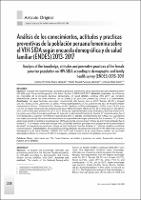| dc.contributor.author | Pasco-Salcedo, Cecilia Verónica | |
| dc.contributor.author | Puescas-Sánchez, Pablo Ronald | |
| dc.contributor.author | Díaz Vélez, Cristian | |
| dc.date.accessioned | 2023-06-01T17:00:00Z | |
| dc.date.available | 2023-06-01T17:00:00Z | |
| dc.date.issued | 2020-12-11 | |
| dc.identifier.citation | Revista del Cuerpo Médico Hospital Nacional Almanzor Aguinaga Asenjo. 2020:13(3). | es_PE |
| dc.identifier.issn | 2227-4731 | |
| dc.identifier.uri | https://hdl.handle.net/20.500.12959/3820 | |
| dc.description.abstract | Objetivo. Analizar los conocimientos, actitudes y prácticas preventivas de la población peruana femenina sobre VIH-SIDA según Encuesta Demográfica y De Salud Familiar (ENDES) 2013-2017. Material y métodos: Se utilizaron los resultados de la Encuesta Nacional Demográfica En Salud (ENDES) continua 2013-2017. Las variables dependientes fueron los conocimientos, las actitudes y las practicas preventivas frente a la enfermedad. Resultados: Los departamentos con mayor conocimiento alto fueron para el 2013: Tumbes (26,7%) y Ucayali (26,7%), Tacna (23,5%), Junín (19,1%), Lima (19,0%) y Lambayeque (18,7%), y para el año 2017 se encontró mayor conocimiento alto en: Callao (16,8%), Tacna (16,4%), Tumbes (16,0%) y Lambayeque (16,0%), Lima (15,6%) e Ica (13,1%). El mayor porcentaje de conocimiento alto (>80%) del grupo etario fueron 30-34 años para el año 2013 y 2017, y 40-44 años para el año 2014, 2015, 2016. El tipo de lugar de residencia fue el Urbano; y Rural en el año 2014. La región natural fue Lima Metropolitana. El lugar de residencia habitual fue la Capital. El nivel educativo fue el nivel postgrado, y Superior- Universitario para el año 2017. El estrato socioeconómico fue el Muy rico. La pregunta con mayor porcentaje de acierto de conocimientos respondida con mayor frecuencia fue la numero 11º ¿Conoce algún lugar donde se realiza la prueba para el VIH? La pregunta con menor porcentaje de acierto de actitudes fue la numero 5 º Si un médico tiene infección por VIH, ¿se le debe permitir que siga con su trabajo en el establecimiento de salud?'. La pregunta con menor porcentaje de acierto de prácticas fue la número 1º ¿Uso de condón en su última relación sexual?'. Conclusiones: El conocimiento de la población peruana femenina sobre VIH-SIDA según Encuesta Demográfica y De Salud Familiar (ENDES) 2013-2017 más frecuente es el conocimiento medio, las actitudes adecuadas se ubican en el percentil 63% en su mayoría, y las practicas preventivas globales son incorrectas. | es_PE |
| dc.description.abstract | Objetive. To analyze the knowledge, attitudes and preventive practices of the Peruvian female population on HIV-AIDS according to Demographic and Family HealthSurvey(ENDES)2013-2017.Materialand methods: The results of the National Demographic Survey on Health (ENDES) continued 2013-2017 were used.Thedependentvariableswereknowledge, attitudes and preventive practices against the disease.Results:The departments with the highest knowledge were for 2013: Tumbes (26.7%) and Ucayali (26.7%), Tacna(23.5%),Junín(19.1%),Lima(19.0%)and Lambayeque (18.7%), and by 2017, higher knowledge was found in: Callao (16.8%), Tacna (16,4%), Tumbes (16.0%) and Lambayeque (16.0%), Lima (15,6%) and Ica (13.1%). The highest percentage of high knowledge (> 80%) of the age group were 30-34 years for 2013 and 2017, and 40-44 years for 2014, 2015, 2016. The type of place of residence was the Urban; and Rural in 2014. The natural region was Metropolitan Lima. The usual place of residence was the Capital. The educational level was the postgraduate level, and Higher-University level for 2017. The socioeconomic stratum was the Very rich. The question with the highest percentage of correctness of knowledge answered most frequently was the number 1º, Do you know where the HIV test is performed? The question with the lowest percentage of correct attitude was the number 5º If a doctor has infection due to HIV, should he be allowed to continue his work in the health facility? The question with the lowest percentage of practice success was number 1º Used Condom use in your last sexual relationship?. Conclusions:The knowledge of the Peruvian female population on HIV-AIDS according to Demographic and Family Health Survey (ENDES) 2013-2017 is the most common knowledge, the appropriate attitudes are located in the 63% percentile, and the practices Global preventives are incorrect. | es_PE |
| dc.format | application/pdf | es_PE |
| dc.language.iso | spa | es_PE |
| dc.publisher | Seguro Social de Salud (EsSalud) | es_PE |
| dc.relation.uri | http://cmhnaaa.org.pe/ojs/index.php/rcmhnaaa/article/view/729 | es_PE |
| dc.rights | info:eu-repo/semantics/openAccess | es_PE |
| dc.rights.uri | https://creativecommons.org/licenses/by-nc-sa/4.0/ | es_PE |
| dc.subject | Infecciones por VIH | es_PE |
| dc.subject | Conocimientos, actitudes y prácticas en salud | es_PE |
| dc.subject | Prevención primaria | es_PE |
| dc.subject | HIV Infections | es_PE |
| dc.subject | Health Knowledge | es_PE |
| dc.subject | Primary Prevention | es_PE |
| dc.title | Análisis de los conocimientos, actitudes y practicas preventivas de la población peruana femenina sobre el VIH-SIDA según encuesta demográfica y de salud familiar (ENDES) 2013- 2017 | es_PE |
| dc.title.alternative | nalysis of the knowledge, attitudes and preventive practices of the female peruvian population on HIV-SIDA according to demographic and family health survey (ENDES) 2013- 2017 | es_PE |
| dc.type | info:eu-repo/semantics/article | es_PE |
| dc.subject.ocde | https://purl.org/pe-repo/ocde/ford#3.03.08 | es_PE |
| dc.identifier.doi | https://doi.org/10.35434/rcmhnaaa.2020.133.729 | |






